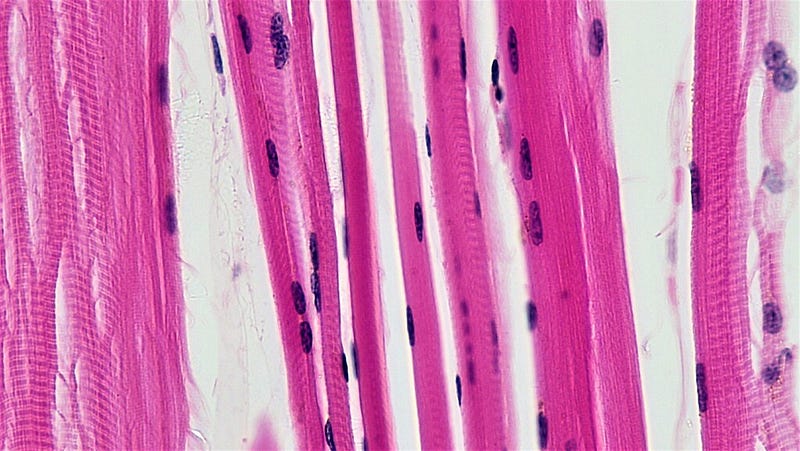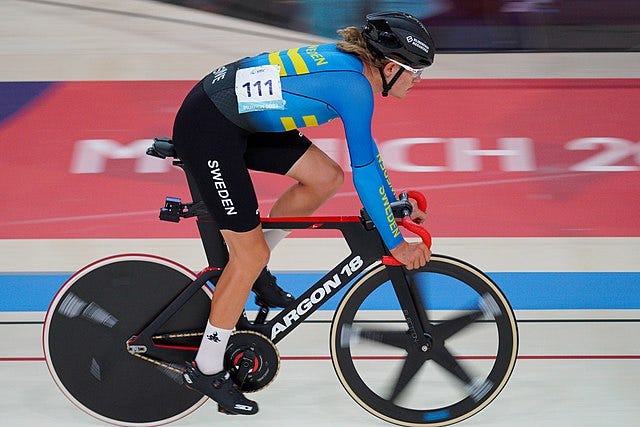HEALTH AND SCIENCE
Can We Lose Fat and Gain Muscle At the Same Time?
How intermittent fasting affects muscle growth, strength, aerobic capacity, and sporting performance

As a weight loss strategy, intermittent fasting has become very popular in recent years. By only eating during part of the day, many find that they consume fewer calories overall and can more easily maintain a healthy weight.
This means losing weight via a calorie deficit or sustaining a stable weight by only consuming as many calories as we burn in a day.
But a healthy weight isn’t our only goal, as a muscly physique is at the top of many wish lists as well. Many people also combine these strategies, attempting to lose fat and gain muscle at the same time.
But losing fat requires a calorie deficit while building muscle tissue requires energy (aka calories). Given this apparent tension, it’s intuitive that optimising for one would create issues for the other.

So, what does this mean for intermittent fasting and muscle gain? Can we do both in parallel? Or do we need to focus on one at a time to get the best results? Let’s find out.
1 — How do we gain muscle?
Before we talk about how intermittent fasting affects muscle growth, we’ll cover some basics about the biology of muscle. If you’re not interested in these details, you can skip to the next main section.
The joys of jargon
First, a tedious (but mercifully brief) point on jargon. According to convention, cells combine to form tissue; tissue combines to form organs; and organs combine to form organ systems and, eventually, an organism.
We’ll refer to muscle cells/tissue interchangeably, as the distinction makes no difference for our purposes.
Types of muscle
Muscle cells are one of our many cell types. In typical fashion for biology, muscle cells can also be divided into four main categories, each with further subtypes.
The four main categories are heart muscle cells, smooth muscle cells, myoepithelial cells, and skeletal muscle cells.
Obviously, heart muscle cells pump blood around our body. Smooth muscle cells do many different jobs, from propelling food down our digestive tract to making our hair stand on end.
Ditto for myoepithelial cells, whose functions range from dilating the pupil to squeezing breast milk, saliva, and sweat from their corresponding glands.

These three types of muscle cells are essential for life and health, but they aren’t what we mean when we talk about gaining muscle.
When we want to gain muscle by working out, we’re talking about the fourth type of muscle cell: skeletal muscle.
Skeletal muscle cells produce virtually all voluntary movement. They can be very large by cellular standards (2–3cm long in adult humans), and are formed by the fusion of precursor cells called myoblasts.
Because of their elongated shape, they are often referred to as skeletal muscle fibers. For convenience, we’ll simply refer to skeletal muscle as muscle, as it’s the type of muscle cell that we’re really interested in.
How muscle develops
Cells adapt to their microenvironment. Thus, based on the conditions that muscle cells experience, they further differentiate into subtypes.
The classic examples are ‘fast’ cells for rapid-twitch contraction and ‘slow’ cells for sustained contraction.
Fast and slow muscle cells also communicate with fast and slow ‘motor’ neurons (i.e., brain cells involved in movement).
Before they become muscle cells (aka muscle fibers), myoblasts replicate by dividing. But once they fuse to become muscle fibers, this ability is lost.
What’s more, animals acquire their total number of muscle fibers very early in life.

In humans, this occurs even before birth, and muscle fibers generally survive for the lifetime of their host organism.
This means that growing muscle involves beefing up the muscle cells we’re born with. So, how do muscle cells grow?
In humans, muscle fibers usually don’t grow in number after birth. But they can still grow in length by adding new myoblasts (muscle precursor cells) to the existing muscle.
Adding new myoblasts also increases girth. This involves expanding the number and length of microfibers that run parallel to each other down the long axis of the muscle cell.
Increased girth is the sort of muscle growth that happens in the case of weightlifters.
Molecular mechanisms of muscle growth
For molecular biology fans, one key mechanism in muscle growth involves a protein called myostatin.
This protein is produced by muscle cells and seems to act as a negative feedback signal to inhibit excessive muscle growth.
This type of negative feedback is very common in biological systems. That’s because it’s fairly simple and prevents runaway activity by turning a process into its own off switch.
For example, in cattle bred to be muscly (i.e., so-called ‘double-muscled’ cattle), it turns out that they have very low levels of the negative feedback protein, myostatin. This reduces the inhibition of muscle growth and allows the cows to become muscle-bound hulks.

This myostatin deficiency is due to a mutation in the gene for myostatin. This has also been shown in laboratory settings with mice, where mutating the myostatin gene increases muscle mass by around 200–300%.
In addition to myostatin, many other mechanisms also contribute to muscle growth.
Ultimately, the balance of excitatory and inhibitory signals in this molecular maelstrom determines whether our muscle cells grow, shrink, or stay the same.
2 — Does intermittent fasting inhibit muscle growth?
Muscle growth requires energy while losing weight requires an energy deficit. Does this mean we can’t intermittently fast and gain muscle at the same time?
Luckily, many groups of researchers have recently published systematic reviews and meta-analyses on this topic.
They pooled evidence on the effects of intermittent fasting on muscle gain and various types of athletic performance.

In a recent article, we compared the major types of intermittent fasting and found that time-restricted fasting seems to be the best available option.
For this reason, we’ll focus on studies that examined how time-restricted intermittent fasting affects muscle and athletic performance.
Most studies examined the effects of a 16:8 regimen (i.e., 16 hours of fasting and 8 hours of daytime eating). We’ll draw on these papers to describe what we know and try to reach some conclusions.
If you’d like to investigate for yourself, I encourage you to follow the links to these published and peer-reviewed papers.
Resistance training
For example, three recent meta-analyses (here, here, and here) studied the effects of time-restricted fasting on muscle gain from resistance training (i.e., using resistance from weights or your own body to build muscle).
The meta-analyses were done by different groups but used similar methods and reached the same conclusions. And since the findings are repeatable, that indicates that they’re reliable, at least based on what we know now.

To judge the effects on fat and muscle mass, the meta-analyses looked at research that tracked people’s body composition (i.e., the body’s proportions of fat and muscle).
Unsurprisingly, most studies found that time-restricted fasting led to weight loss, confirming that the study participants were in a calorie deficit.
So, how did this calorie deficit affect muscle mass? Most studies found that time-restricted fasting made no difference to gains in muscle, while a small minority of studies found that it actually improved gains in muscle mass.
Aerobic capacity and baseline strength/muscle
A recent meta-analysis also examined how time-restricted fasting affects oxygen consumption (aka ‘aerobic capacity’) across 28 research papers.

Time-restricted fasting improved aerobic capacity and did not negatively affect baseline muscle strength.
Another meta-analysis by a different group also came to similar conclusions.
However, one caveat. Time-restricted fasting can cause muscle loss if the window for eating is too narrow, like a 20:4 regimen.
This tells us that time-restricted fasting can be detrimental if taken too far.
Athletics and sport
Since a 16:8 schedule of time-restricted fasting does not seem to negatively affect muscle growth, strength, and aerobic capacity, how does it affect athletic performance?
Unfortunately, results from studies on this topic vary, depending on the sport, and sometimes contradict each other.

For example, some found that time-restricted fasting impaired athletic performance among rowers and cyclists.
However, this may not be true for other activities, such as sports involving jumping.
In contrast, other studies on cyclists found no detrimental effects on endurance or peak performance, while some studies even found a mild benefit, at least among young, elite cyclists.
Given such messy results, we must defer judgment until we know more. But for now, if you play sport, especially at a high level, be cautious with time-restricted fasting.
Conclusions and takeaways
Let’s sum this up.
If you want to gain muscle via resistance training, studies suggest that time-restricted fasting (e.g., the 16:8 diet) won’t impair your progress.
To answer the question we began with, this means we can gain muscle and lose fat at the same time.
Time-restricted fasting regimens also seem to boost aerobic performance, at least in studies so far. This is good news for anyone who enjoys running and is interested in time-restricted fasting.

Given these benefits, you’d hope that time-restricted fasting would be neutral or even beneficial for sporting performance. Sadly, however, the evidence is currently unclear.
For now, all we can do is reserve judgment and wait for more research. But if you’re an athlete or just a sporty person, and you’d like to try time-restricted fasting, do it cautiously, pay attention to your body, and don’t be afraid to make adjustments.
Much remains to be learned, as the current body of evidence is still fairly small, and most research involves people who are either overweight or very fit.
It will take time for the full picture to emerge as researchers gradually broaden their studies to include a more representative sample.
Nothing is certain, and we’re all different to some extent. But if you’d like to lose weight and gain muscle, something like a 16:8 schedule may be a good place to start, as it preserves muscle and can improve aerobic capacity.
Good health, and thanks for reading!






